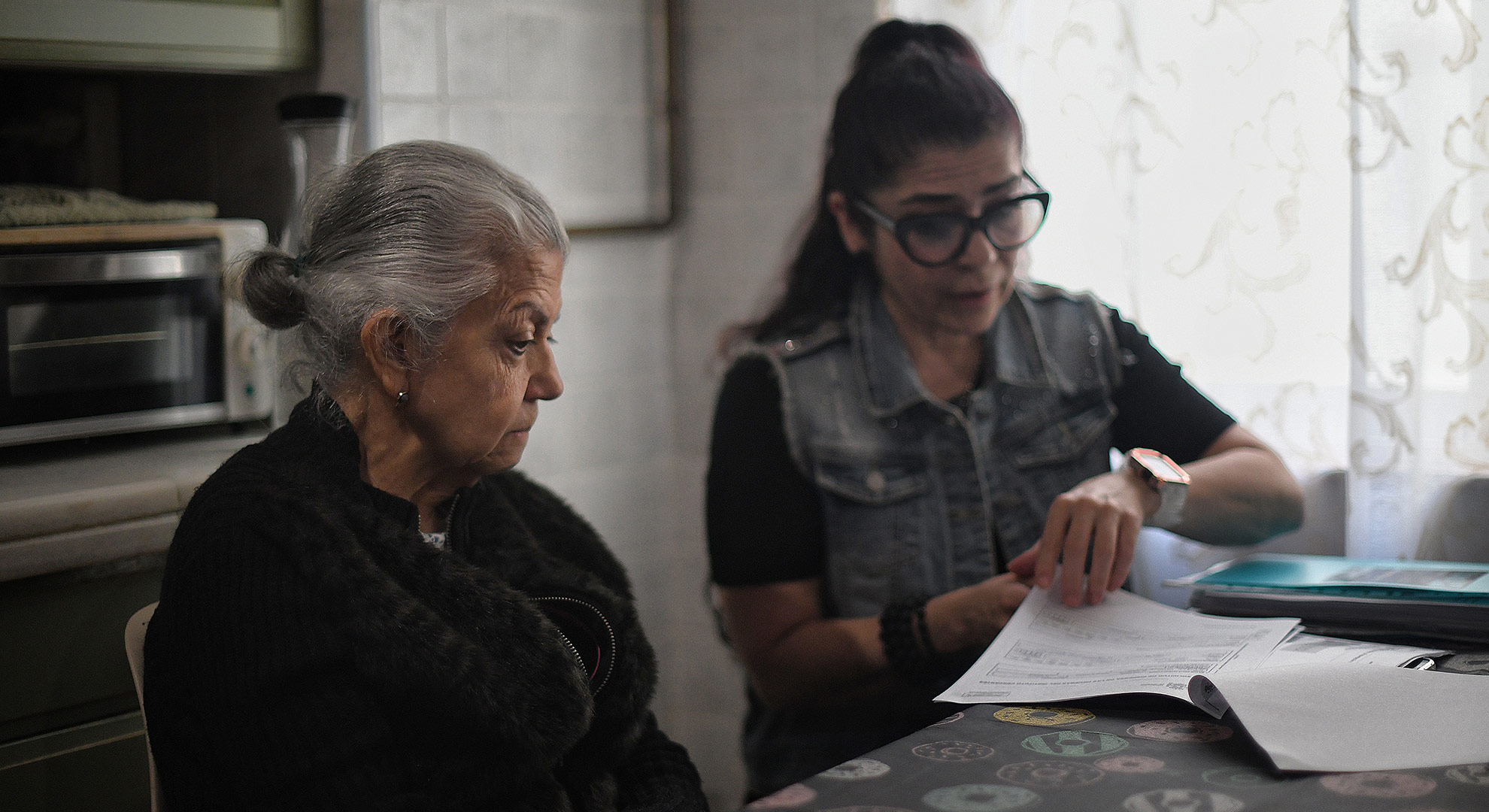Becoming a European citizen is an obstacle race: the paths to naturalization
European Union countries naturalised just 2.64% of their non-national population in 2022. The process is full of obstacles and often takes years.

Magali Varela de Torres, who moved from Venezuela to Madrid, Spain, in 2017, is the only member of her nuclear family who is not yet Spanish. Her husband was Spanish and now her daughter, son and granddaughter are Spanish, too. Varela de Torres, a retired social worker who has official recognition of disability due to her Alzheimer’s, has lived in Spain long enough to apply for citizenship, too. But Spain’s Ministry of Justice has not processed her requests for a health exemption from the culture test required for naturalisation. Her daughter Adriana Torres has submitted three requests over the last three years and keeps getting the same robotic reply from the ministry asking for information she has already submitted. After listening to her daughter tell the story, Varela de Torres says, “It’s as if I don’t exist.”

adriana_reducido
Magali and her daughter Adriana | Photographer: Fernando Sánchez
Varela de Torres had been waiting a year since her first request when, in June 2022, the Spanish government naturalised Lorenzo Brown, an American basketball player, via a much more agile procedure: a letter of naturalisation. With seven lines of text in the official state gazette, Spain made Brown a Spanish citizen. Brown had just signed with the Maccabi basketball team in Tel Aviv, Israel, and had never lived in Spain or played for a Spanish team. But thanks to the letter of naturalisation, he became eligible to play as the point guard the Spanish national team needed to win the Eurobasket tournament that year. Spain used the same mechanism to naturalise Brazilian businessman Ricardo Steinbruch, American singer Ricky Martin and Peruvian writer Mario Vargas Llosa.
The difference between the processes undergone by Varela de Torres and Brown reflect the enormous disparities in access to nationality in the European Union, differences that exist both between the countries that make up the EU, as well as within the same country, depending on the context of the applicant. Most European countries offer shortcuts to naturalisation to a tiny number of people for achievements in specific areas, such as science, sports, or culture, while others leave the conditions up to the government of the day. Spain publishes a record of the people it naturalises at its discretion, but has no official limits on the process, which last year naturalised 108 people, compared to the hundreds of thousands of people it naturalised by conventional methods. Austria naturalised 40 people on similar legal grounds, “special interest of the Republic,” in 2023.
For a few years, Malta, Cyprus and Bulgaria included investments in the country as a path to citizenship—even for non-residents. Since then, pressure from other European countries has cut off that path in all but Malta, which is defending itself against a suit on the matter in the Court of Justice of the EU.
Most aspiring Europeans must undergo a much lengthier and more difficult process. The difference between Varela and Maayouf’s experiences is representative of the huge disparities between who gets to be European and how they achieve it, both within and between European countries. Becoming a citizen, or not, is a major factor in the lives of people who move between countries. Citizenship “unlocks the rights that individuals should have as full members in a state,” says migration researcher Jelena Dzankic, co-director of the Global Citizenship Observatory and a part-time professor at the European University Institute (EUI) in Florence, Italy.
Naturalisation offers people better lives. “Researchers have found a very strong citizenship premium,” says citizenship expert Thomas Huddleston at the University of Liège in Belgium, “Naturalised citizens are more likely to move up in their life, in their employment and their housing situation because they are better seen by the public and by employers.” Naturalising immigrants “is one of the best investments that a society can make in integration because it secures immigrants’ futures in the country, so that they can have a clear vision for what their future could be, how investing in their language and country-specific skills can pay off longer term,” Huddleston says.
A hidden benefit of naturalisation is the ease with which a new citizen can go back to their country of origin, without fear of losing their right to live in their new country. That empowers people to adapt to changing economic circumstances, says migration expert Claudia Finotelli of the Complutense University in Madrid, Spain.
Naturalisation also has an equalising effect between women and men, says economist Christina Gathmann of the Luxembourg Institute for Socio-Economic Research (LISER). “We see the biggest impacts on women who are often disadvantaged. We also see big effects in fertility and marriage behaviour. And we also see it for the second generation.” Women who gain citizenship invest more in their careers, and postpone marriage and childbearing until they are ready, both of which help them assimilate in their new countries and exercise more autonomy within their marriages.
Despite these advantages, European countries naturalise only a small fraction of their non-national residents each year. In 2022, the European Union, with a population of 448.4 million people, naturalised fewer than 1 million people. Together, European countries host 41.2 million non-nationals. Sweden naturalised the most as a fraction of its non-national population at over 10%, followed by the Netherlands and Italy. Austria, Estonia and Latvia, at around half a percent, naturalised the fewest of their non-national residents.
Different people, different paths
Many factors influence those naturalisation rates: some factors depend on the states and others depend on the individuals. A common method of obtaining naturalisation is to document a certain number of years of legal residency, alongside meeting additional integration requirements. Other methods include marrying a citizen, usually along with demonstrating some years of legal residency, or being a descendant of a citizen. However, being a direct descendant of a legal resident who is not a citizen of a European country does not guarantee an easy path to citizenship.
European countries differ in how long they want people to wait. A typical requirement is 5 years, such as in France. However, Spain and Italy require 10 years in ordinary cases.
The role of an immigrant in their new society also affects the requirements that apply. Are you already a permanent resident of Luxembourg and getting married to a Luxembourger? Congratulations: you can apply to be European right after the wedding bells. Other countries reduce the residency requirement by a couple of years for spouses of their own citizens.
People who do desire naturalisation soon discover that something they didn’t choose, such as their country of origin and their ancestors, can make a big difference to their path to becoming a European. Spain favours certain ex-colonies. Portugal, like Spain, makes it easier for Sephardic people, descendants of Jews both countries exiled in the 15th century, to obtain nationality. Finland and Denmark shorten the wait time and otherwise facilitate the requirements for citizens of other Nordic countries. Several other European countries make it easier for people in their respective diasporas to acquire nationality.
Barriers, both visible and invisible
For the more common naturalisation by residency route, which require a minimum wait, most countries have additional requirements, such as a certain number of years of working, language or culture tests, documentation from applicants’ home countries, all of which can serve as barriers to entry. People applying for naturalisation via other routes, such as refugees or spouses of citizens, often face similar requirements.
Caterer Fadi Zaim in Berlin, Germany, represents a best-case scenario. His family obtained one of 300 invitations to apply for refugee visas in Germany after Syria’s 2011 civil war began. He began studying German soon after arriving, and eventually tested to the second-highest possible level, C1, he says, well beyond the required B1, the fourth-highest level. Then, he took an integration course and earned a perfect score on the exam, he says, “I was so into it. I never had a full mark in any exam in my life.”
Not all applicants can handle such tests, and states have written laws to accommodate them, but do not always put them into practice. For example, the retired social worker Varela de Torres is still waiting for Spain to allow her to request the exemption to which she is entitled for her Alzheimer’s. “I consider the naturalisation test easy,” she says, “but when I go to do it, it gets away from me, it gets away from me, it gets away from me and so…” she trails off.
“The thing that most worries us at Caritas is access to the exemptions,” says migration lawyer Diego Fernández-Maldonado of the charity Caritas España in Madrid. “It’s difficult to get an answer and they don’t always issue them even in cases that seem pretty obvious…they are also often partial and refer for oral examination people who aren’t qualified.”
There are also work or income requirements. In more than a dozen European countries, one of the requirements for citizenship is a stable source of income. Housekeeper Natalia in Athens, Greece, who spoke on condition of not giving her last name, applied for Greek citizenship in 2014, 17 years after moving to Greece from Moldova. When her children reached university age, they applied for and obtained Greek citizenship and encouraged her to do so, too. Natalia recalls that at first, the whole family assumed they would move back to Moldova, but “the years went by and they said, ‘Mum, we have our friends here, our studies here, we’re not going back.’ Tell me: how do you leave your children and go without them?”
Natalia passed the language and culture tests in 2023 but the Greek administration rejected her citizenship application because she did not reach the minimum required annual income of 8,450 euros for the years in question. “I’ve been here legally since 1997 and all these years, I’ve been living somehow, right? But not with as much as they demand,” Natalia says. In other countries, such as Ireland, it’s not officially required, but in practice it is: according to a report by the European Migration Network, one of the documents required by the Ministry of Justice is a proof of income that shows you have the economic means to support yourself without recourse to social services, and the lack of this document influences the rejection of applications.
Entrepreneur Dzimtry Bileichyk in Madrid, Spain, who began applying for naturalisation in Spain in 2022, has tallied up the direct costs of his application. Between fees from his own embassy, language and integration tests in Spain, the naturalisation fee, and solicitor’s fees, Bileichyk tallies having spent €829.05 so far. Spain’s naturalisation fee of €104.05 is at the low end of the range in Europe, which reaches as high as €1023 in The Netherlands, though several countries have no charge at all. In practice there are many other fees, such as those for tests, translations, or solicitors, that amount to additional unwritten barriers.

dimitri_reducida-3c8d8a
Dzimtry Bileichyk | Photographer: Fernando Sánchez
Even people who do manage to overcome the official and unofficial barriers to apply often face uncertainty in the timing of the response to their application. At any rate, states frequently take longer than their own official time limits for resolving naturalisation applications. Greece, for example, states in its law that the administration has only 12 months in which to resolve naturalisation applications. The mean wait was closer to 6 years before a 2021 reform, especially in the bigger cities, where the number of applicants overwhelms the administrative resources allocated, according to Generation 2.0, a civil society organisation in Athens, Greece. It is too soon to know what the mean wait is under the new law, or how many of the more than 30,000 applicants still waiting to hear will update their applications to meet the new requirements.
In Spain, “there’s discretion in the timeframes that we don’t understand,” says the migration lawyer Fernández-Maldonado. “People who have applied for naturalisation long before others are still waiting while the later applicants get their resolution.” Some may be due to public entities favouring digital applications over paper applications, Fernández-Maldonado says. Bileichyk, however, who has compared notes with other people in his situation, says “I receive one thing and other Belorussians receive another thing, though we’ve provided all the same papers.” He cannot explain the differences.
Bileichyk left Belarus in 2011 to avoid military conscript hazing, called dedovshchina, and later began living in Spain. “During the 2020 Belarus elections I participated in an independent exit poll at the exit to the embassy, part of a global movement of Belarusians. And officials recognised me at the embassy,” he says. By 2022, Bileichyk began gathering his papers to apply for naturalisation in Spain.
In September 2023, Belarus issued a decree preventing its citizens from renewing passports or conducting other routine business at embassies. The decree forces the perhaps half a million Belarusians who left after the 2020 elections to choose between a risky return and losing the ability to live legally abroad. Bileichyk was lucky because he had already applied for nationality in Spain, but the unpredictable and years-long wait times for Spanish naturalisation meant he could not know if he would obtain citizenship here before his Belarusian passport, and thus his legal residency in Spain, expired in 2026.
Falling into irregularity, even for people who later manage to overcome it, delays their integration in addition to endangering them until they manage to regain legal residency. Writer and translator Elvira Mujčić in Rome, Italy, was a refugee from Bosnia in Italy in the 1990s when her residency permit expired while under consideration for renewal. “Even just getting out of the country was complex,” she recalls, “we had these receipts attesting to the request for renewal, and when I got to customs, I would start justifying myself by pulling out all the possible and imaginable papers that I was carrying around.”
Indeed, a country’s policies regarding steps previous to naturalisation, such as regularising residency, can have a big impact on its ability to integrate and naturalise potential citizens, the Cáritas lawyer Fernández-Maldonado says: “The fact that people have to stay so long irregularly, even if they actually reside in Spain, means that they cannot accumulate the required legal residence time to be able to access nationality.”
Work requirements, such as those that prevent the housekeeper Natalia from naturalising in Greece, also affect the ability of vulnerable people to remain in their host countries long enough to obtain citizenship. “My mother always had to have a job, otherwise she would lose her residence permit,” Mujčiċ says. “We did not have the right for something to happen to us, such as not having a job.”
“These legal and practical obstacles seem to have the greatest impact, unfortunately, on the immigrants who would benefit the most from naturalisation, because they get the greatest citizenship premium,” says the University of Liège citizenship expert Huddleston.
In May 2024, the entrepreneur Bileichyk learned that Spain’s Justice Ministry had resolved his application in his favour. He is now waiting for a swearing-in date, after which he will be a citizen.
Some unofficial barriers are cultural, or religious. In Denmark, for example, the final step of naturalisation takes place in an obligatory ceremony in which applicants must shake hands with a local official, who is often male. The EUI migration researcher Dzankic says, “This might be problematic for people from certain religious communities. This is one of the provisions that seem neutral on paper but entail discriminatory elements.”
Overcoming all these barriers to naturalisation is in the interest of the host countries. “If you accept immigrants into the country you want to make sure they prosper in order to make them contributors to your economy and society,” Gathmann says. Naturalisation also helps create “a more diverse and democratic environment, for everyone living in the country,” Dzankic adds.
Antidiscrimination activist Youseff Ouled of Rights International Spain in Madrid moved to Spain as a child and later spent years applying for Spanish citizenship for himself and his family. Now that he has it, he says: “It’s an umbrella: when you don’t have it, you’re very aware of not having it and when you have it, well you just kind of take it for granted.”
Original source: https://civio.es/2024/05/28/one-small-step-for-a-few-one-giant-leap-for-the-rest-how-to-become-a-european-citizen/
